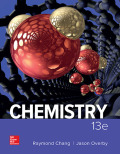
(a)
Interpretation:
The type(s) of intermolecular forces existing in between the molecules of the given compounds have to be identified.
Concept Introduction:
Intermolecular forces are the forces existing between molecules, atoms, ions or dipoles.
Depending upon the type of species involved, the intermolecular forces can be classified as follows:
- Dipole-Dipole interactions.
- Ion-Dipole interactions.
- Dipole-induced dipole interactions.
- Ion-induced dipole interactions.
- Dispersion forces.
- Hydrogen bonding.
- Dipole-Dipole interaction is the interaction between two polar molecules which have net dipole moments.
- Ion-Dipole interaction is the interaction between an ionic species (such as cation or anion) and a polar molecule.
- Dipole-induced dipole is the interaction between an atom (non- polar species) and a polar molecule. In this interaction, a polar molecule induces its dipole moment to a non-polar species which lacks dipole moment.
- Ion-induced dipole interaction is the interaction between an atom (non- polar species) and an ionic species. In this interaction, an ionic species such as cation or anion, induces dipole in a non-polar species which lacks dipole moment.
- Dispersion force is the interaction between non-polar molecules.
- Hydrogen bonding can also be defined as coulombic attraction between the hydrogen atom and an electronegative atom. It is a special type of Dipole-Dipole interaction.
(b)
Interpretation:
The type(s) of intermolecular forces existing in between the molecules of the given compounds have to be identified.
Concept Introduction:
Intermolecular forces are the forces existing between molecules, atoms, ions or dipoles.
Depending upon the type of species involved, the intermolecular forces can be classified as follows:
- Dipole-Dipole interactions.
- Ion-Dipole interactions.
- Dipole-induced dipole interactions.
- Ion-induced dipole interactions.
- Dispersion forces.
- Hydrogen bonding.
- Dipole-Dipole interaction is the interaction between two polar molecules which have net dipole moments.
- Ion-Dipole interaction is the interaction between an ionic species (such as cation or anion) and a polar molecule.
- Dipole-induced dipole is the interaction between an atom (non- polar species) and a polar molecule. In this interaction, a polar molecule induces its dipole moment to a non-polar species which lacks dipole moment.
- Ion-induced dipole interaction is the interaction between an atom (non- polar species) and an ionic species. In this interaction, an ionic species such as cation or anion, induces dipole in a non-polar species which lacks dipole moment.
- Dispersion force is the interaction between non-polar molecules.
- Hydrogen bonding can also be defined as coulombic attraction between the hydrogen atom and an electronegative atom. It is a special type of Dipole-Dipole interaction.
(c)
Interpretation:
The type(s) of intermolecular forces existing in between the molecules of the given compounds have to be identified.
Concept Introduction:
Intermolecular forces are the forces existing between molecules, atoms, ions or dipoles.
Depending upon the type of species involved, the intermolecular forces can be classified as follows:
- Dipole-Dipole interactions.
- Ion-Dipole interactions.
- Dipole-induced dipole interactions.
- Ion-induced dipole interactions.
- Dispersion forces.
- Hydrogen bonding.
- Dipole-Dipole interaction is the interaction between two polar molecules which have net dipole moments.
- Ion-Dipole interaction is the interaction between an ionic species (such as cation or anion) and a polar molecule.
- Dipole-induced dipole is the interaction between an atom (non- polar species) and a polar molecule. In this interaction, a polar molecule induces its dipole moment to a non-polar species which lacks dipole moment.
- Ion-induced dipole interaction is the interaction between an atom (non- polar species) and an ionic species. In this interaction, an ionic species such as cation or anion, induces dipole in a non-polar species which lacks dipole moment.
- Dispersion force is the interaction between non-polar molecules.
- Hydrogen bonding can also be defined as coulombic attraction between the hydrogen atom and an electronegative atom. It is a special type of Dipole-Dipole interaction.
Want to see the full answer?
Check out a sample textbook solution
Chapter 11 Solutions
Chemistry
- Can I get help on drawing my arrowsarrow_forwardCan I get helpp drawing my arrowsarrow_forwardWhich of the m/z values corresponds to the base peak in the mass spectrum shown? 100 80 A. 45 B. 44 C. 29 D. 15 Intensity 20 0 10 20 30 40 B- m/z -8 50 E. 30 Which of the m/z values correspond to the molecular ion for the compound shown? A. 18 B. 82 OH C. 100 D. 102 E. 103arrow_forward
 ChemistryChemistryISBN:9781305957404Author:Steven S. Zumdahl, Susan A. Zumdahl, Donald J. DeCostePublisher:Cengage Learning
ChemistryChemistryISBN:9781305957404Author:Steven S. Zumdahl, Susan A. Zumdahl, Donald J. DeCostePublisher:Cengage Learning ChemistryChemistryISBN:9781259911156Author:Raymond Chang Dr., Jason Overby ProfessorPublisher:McGraw-Hill Education
ChemistryChemistryISBN:9781259911156Author:Raymond Chang Dr., Jason Overby ProfessorPublisher:McGraw-Hill Education Principles of Instrumental AnalysisChemistryISBN:9781305577213Author:Douglas A. Skoog, F. James Holler, Stanley R. CrouchPublisher:Cengage Learning
Principles of Instrumental AnalysisChemistryISBN:9781305577213Author:Douglas A. Skoog, F. James Holler, Stanley R. CrouchPublisher:Cengage Learning Organic ChemistryChemistryISBN:9780078021558Author:Janice Gorzynski Smith Dr.Publisher:McGraw-Hill Education
Organic ChemistryChemistryISBN:9780078021558Author:Janice Gorzynski Smith Dr.Publisher:McGraw-Hill Education Chemistry: Principles and ReactionsChemistryISBN:9781305079373Author:William L. Masterton, Cecile N. HurleyPublisher:Cengage Learning
Chemistry: Principles and ReactionsChemistryISBN:9781305079373Author:William L. Masterton, Cecile N. HurleyPublisher:Cengage Learning Elementary Principles of Chemical Processes, Bind...ChemistryISBN:9781118431221Author:Richard M. Felder, Ronald W. Rousseau, Lisa G. BullardPublisher:WILEY
Elementary Principles of Chemical Processes, Bind...ChemistryISBN:9781118431221Author:Richard M. Felder, Ronald W. Rousseau, Lisa G. BullardPublisher:WILEY





